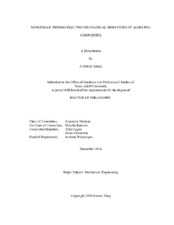| dc.description.abstract | The focus of this study is to understand the influences of blending silver (Ag) phase into barium titanate (BaTiO3) ceramic on its thermal, mechanical and dielectric properties. Silver-barium titanate (Ag/BaTiO3) active composites with varying silver composition were fabricated using powder metallurgy method. Coefficient of thermal expansion (CTE) and heat capacity were measured by thermal mechanical analyzer (TMA) and differential scanning calorimetry (DSC), respectively. Hot disk technique was employed to determine the thermal conductivity. Addition of silver did not change the phase transformation temperatures. CTE stays constant at each crystalline phase, but increases as BaTiO3’s crystal structure changes from orthorhombic to tetragonal phase and further to cubic. Increase of silver content significantly enhances the thermal conductivity. Elastic and dielectric constants were determined using resonant ultrasound spectroscopy (RUS) and dielectric (impedance) spectroscopy, respectively. Young’s modulus decreases as the increase of silver composition, while the dielectric constant was significantly improved by blending silver. Two peaks were observed on dielectric constant around the transformation temperatures, with a larger magnitude at the Curie point.
Micromechanics models based on detailed microstructures, either generated randomly by computer algorithm or created by converting scanning electron microscope (SEM) images, were created to numerically study the effects of microstructures on the effective properties of Ag/BaTiO3 composite. Numerical results showed that microstructure induced anisotropy is negligible and the effective properties are insensitive to loading directions. Effective CTE is insensitive to the yielding of silver particles, porosity, and the elastic modulus of BaTiO3. The predictions of CTE and elastic constants were pretty close to the experiment results, while the effective thermal conductivity and dielectric constant predictions underestimated the measured values.
The hysteretic mechanical behavior of Ag/BaTiO3 composite was measured under cyclic uniaxial compressive loading using materials test system (MTS). Specimens with 5 vol% and 13 vol% silver composition were broken before the maximum stress was reached. The fractured specimens showed a fracture angle of approximate 45⁰C. Furthermore, a one-dimensional constitutive model based on the thermodynamics of irreversible process was presented to model the hysteretic response from experiment. | en |


